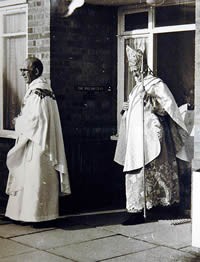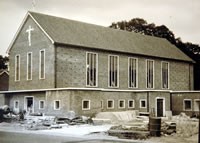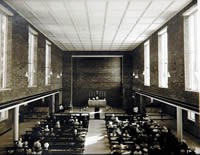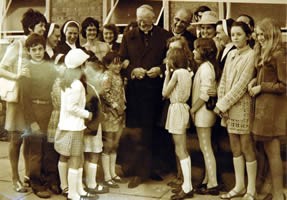
St Alban, the first English martyr, gave his life for Christ just down the road in the city which now bears his name around the year 287. It is not surprising, therefore, that Hatfield has a long Catholic history. Indeed, the second Council of the English Church (recorded by the Venerable Bede) was held here in 679.
At that Council the English Bishops affirmed their unity with Rome and rejected theological error.
In Saxon times the king gave Hatfield to the monks of Ely, hence its official title of “Bishop’s” Hatfield and the fact the ancient church is dedicated to St Ethelreda, the royal foundress of the Ely monastery. Cardinal Morton, Bishop of Ely, built the Old Palace at Hatfield – the surviving wing of which is in the grounds of Hatfield House.
St Ethelreda’s was for centuries a Catholic place of worship, but following the Reformation, Mass was not said regularly in Hatfield until the arrival of Fr Kenelm Vaughan (brother of the Cardinal Archbishop of Westminster) around a century ago.
Mass was first said in rented rooms on the old Great North Road until he later built a house and chapel in St Albans Road. Fr Vaughan founded the “Brotherhood of Expiation” for the conversion of England and “in reparation for the sacrileges committed at the Reformation, especially the profanation of ancient churches.”
Following Fr Vaughan’s death in 1909 Mass was offered by visiting priests of the Westminster Diocesan Missionary Society until 1922 when it became a house of study for convert clergy known as St Charles’ House.
In 1925 Carmelite nuns built a convent on the site of the old Hatfield Brewery in Batterdale, by the railway station, and remained there until 1938. Local Catholics were able to attend Sunday Mass in the convent chapel when Vincentian Fathers came up from Potter’s Bar. The local Catholic presence was increased by the arrival of the St John of God brothers at Barvin Park and Dominican Sisters who opened a school at Ponsbourne Park.

However, normal Catholic parish life really resumed when the Diocese sent Fr David Arbuthnott to Hatfield in 1929. St Teresa’s (re-named Marychurch when the new church was built) was opened in 1930 and the parish of Hatfield was officially set up in 1937. In 1955 Fr John Milne succeeded Fr Arbuthnott as parish priest of St Teresa’s. Hatfield was changing rapidly; it was no longer a small Hertfordshire village dominated by the Cecil-Gascoyne estate. The opening of the De Havilland aircraft factory and Hatfield’s selection as one of the “New Towns” to receive the overflow population from London after the Second World War meant there was rapid expansion.
This was particularly true of South Hatfield, built to house the workers in the aerospace industry.
The Diocese of Westminster and Fr Milne recognised the need to meet the demands of the growing Catholic population. In 1959 Bl. Philip Howard School was opened in Woods Avenue, served by the Sisters of Mercy who moved into a new convent in Sycamore Avenue. Also in 1959 Hatfield was officially divided into two parishes and Fr Milne was appointed parish priest of the New Town. At first there was no church; Mass was offered initially in the school and then in the church hall. The first Mass in St Peter’s church was celebrated on 9 July 1961.

There has been plenty of changes over the last half century. The church roof was lowered in the 1980s to address cracking in the window surrounds and problems with heating.
There have been changes to the sanctuary and the church hall was re-modelled when the adjoining land was sold off. The Sisters of Mercy have left the parish. The closure of British Aerospace in 1992 badly affected the local economy.

And yet the parish continues to thrive and support a vibrant Catholic population.
The University of Hertfordshire has grown out of the old aerospace technical college and Hatfield Polytechnic to become a huge, successful educational establishment of 23,000 students.
We welcome many of them here to Mass. The arrival of new Catholic immigrants from around the world adds life and diversity to our parish. Yet, as always, we remain firmly rooted in our faith in Our Lord Jesus Christ and it is on this basis that we look forward with hope and confidence to the next half century and beyond.